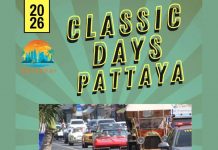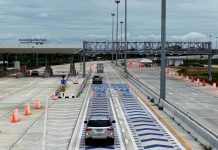Chanthaburi province is like a miniature Thailand – a land of natural wonders including beaches, mountains, tropical forests, rivers and waterfalls, and some of the county’s largest mangroves. You can explore ancient royal and colonial history, and visit temples and fishing villages that have retained their old charm in this picturesque province bordering Cambodia.
Chanthaburi is an agricultural powerhouse that produces exotic tropical fruits found in few other places, spices, seafood in abundance, as well as cash crops such as rubber.

In recent years, Chanthaburi has been at the forefront of budding sustainable and organic farming efforts in Thailand and there is also a growing movement in green tourism. Situated 250 kilometres southeast of Bangkok, nature lovers find a paradise in this province offering mountain treks, river and sea boating, and beach activities.

The province is probably best known to many for its weekend gem market in Chanthaburi town where wheeler-dealers from all corners of the world meet to trade precious and semi-precious stones. With the border crossing into neighbouring Cambodia open, Chanthaburi has become even more of a crossroads and a logical stop while travelling in the region.
City of the Rabbit
The rabbit is the province’s symbol and stands for peace. Chanthaburi town is the province’s centre for agriculture, transportation and trade. History plays an important role throughout the province in defining its character, and many places are open to visitors.
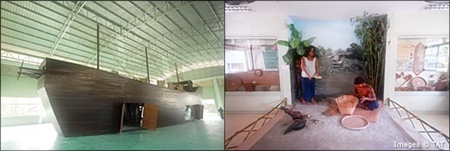
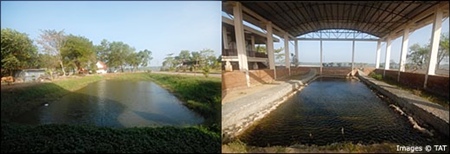
King Taksin Shipyard – also known as Samet Ngam Shipyard – in the district of Nong Bua to the south of Chanthaburi town is where King Taksin the Great chose to build his fleet of ships and form his army. He sailed these along the coast and up the Chao Phraya river to repel the Burmese who had sacked the ancient Siamese capital of Ayutthaya in 1767. The shipyard where he built this armada gives an idea of what that great fleet must have been like.
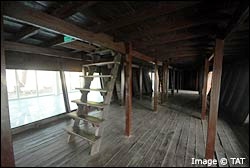
The Maritime Museum in Tha Mai southwest of the main town is another place to seek insights into the shipping history of the province. One maritime story concerns the survivors of a Chinese shipwreck who settled in Kung Wiman – ‘Heaven on Earth’ – and mixed with the sea gypsies who had first settled in Hua Laem area located in the southwest corner on the province.
Noen Wong Fortress was built in 1834 in the reign of King Rama III during the current Chakri dynasty which dates from 1782 – soon after King Taksin and his forces defeated Burmese invaders. Noen Wong Fortress served as a defensive position against Vietnamese forces, and its red brick walls still stand south of town. Many of the fort’s 39 canons also remain in place. The 106-acre grounds inside the walls today house offices of the Fine Arts Department and other buildings.
Chanthaburi honours King Taksin with a large bronze statue of him riding a horse with four of his generals alongside. It honours the ancient warrior king’s choice of Chanthaburi as the place to raise his army to liberate Siam from the Burmese. It has a large park and lake that are popular with joggers, picnickers and people in search of a little peace.
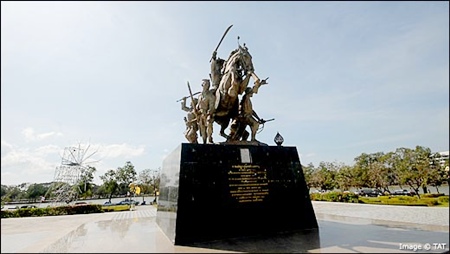
Vietnamese Catholics first settled along the Chanthaburi River in what is now Chanthaburi town in the 19th century. The original thoroughfare runs along the river and is now known as Sukhapiban Road. The Vietnamese were fleeing religious persecution in southern Vietnam. Vietnamese who joined later were escaping French rule the first half of the last century. Another wave of refugees arrived after the American War in Vietnam ended in 1975.
The riverside community took action in 2009 by forming itself into the Committee of Chanthaboon Waterfront with the express purpose of preserving the local heritage. A one-kilometre long stretch now offers numerous cafés, restaurants and a gallery among the old wooden townhouses and shrines. With its riverside views, this is a great place for a stroll through history or a pause for something to eat or drink.
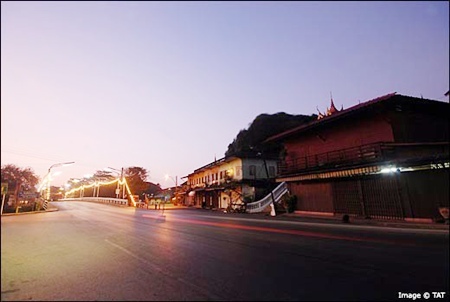
On the other side of the river sits Thailand’s largest French-style cathedral. First built as a missionary chapel in 1711, it later underwent four renovations, the last more than a hundred years ago. A footbridge across the Chanthaburi River leads to the cathedral, and there are several hotels within easy walking distance.
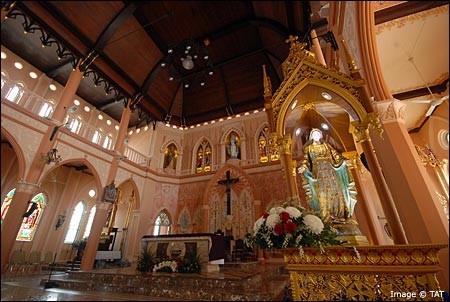
Chanthaburi province is one of the few parts of Thailand that was occupied by a foreign power in modern times having been under French rule from 1893 until 1905. It was administered as part of French colonial Cambodia, and remnants of that period are still evident.
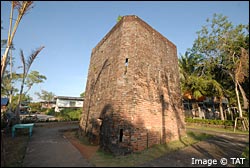
Laem Singh on the coast southeast of town was an important French port and administrative centre. An old building that used to house French officers still stands, as does Khuk Khi Kai – ‘Chicken Shit Jail’ – where the French interned prisoners in a brick tower standing seven metres high and 4.4 metres square at the base.
King Chulalongkorn (Rama V, r. 1868-1910) negotiated Chanthaburi back from the French in a trade in which Thailand conceded parts of what is now western Cambodia.
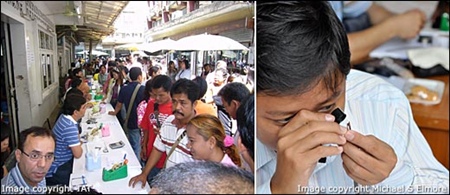
Gems
Chanthaburi has one of the biggest weekend gem markets in the world and is a global centre for gem treatment, cutting and polishing. On Saturdays and Sundays, many of the streets near the river in the old part of town are packed with wheelers and dealers of all sorts of gems from around the world.
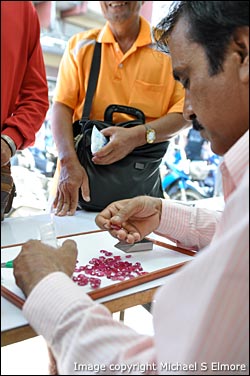
For decades, the province was known for the sapphires and rubies dug from its soil, and the cutting and polishing industry that grew up around them. When the mines started drying up about a decade ago, the industry continued to thrive as a treatment centre and market for buying and selling.
It’s a truly global market with stones from Africa in particular becoming more common the past few years. Several little gem museums are open to the public in town and anyone is welcome to attend the weekend market.
Temples
Chanthaburi, like the rest of Thailand, is sprinkled with temples in every village and town. Wat Khao Sukim stands out. Only built in 1966, it is a popular place of meditation standing on a 1,296-acre hill 15 kilometres north of town. You can walk to the top of the hill or take a cable car. The temple has a museum with religious objects and antiques on display.
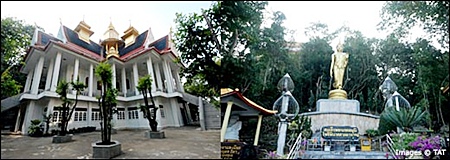
Phliu waterfall in Namtokphliu National Park is about 15 kilometres southeast of town. There is a chedi and small pyramid built by King Rama V in honour of Phra Nang Chao Sunanthakumarirat, one of his queens who drowned in a boating accident on the Chao Phraya river along with their infant daughter.

It is a popular visiting spot among Thais for the beauty of the forest, the three-level waterfall and the royal connection. Feeding the fish in the park is also popular.
Another place with royal connections is Rambhai Barni Rajabhat University. A peaceful campus just outside of town where the widow of King Prajadhipok (Rama VII, r. 1925-1935), HM Queen Rambhai Bami, lived between 1950 and 1972 before she donated the grounds to the Ministry of Education.
This was the home in which she settled after she returned to Thailand from England in 1949 where she had lived since the 1930s following the end of absolute monarchy in 1932.
King Prajadhipok died there in 1941 after abdicating in 1935.
Fruits and Food
Local orchards are famous for a full range of tropical fruits including durian, rambutan, mangosteen, lychee, rose apples and zalacca. More common bananas, watermelons and papayas are also abundant.
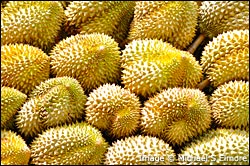
Many consider durian to be the king of fruits, and this spikey, football size fruit is known for the pungent smell that has seen it banished from many hotels and airports. But the fruit has a dedicated following and to locals it smells like money.
The province grows about 500,000 tonnes of assorted fruit for export each year. According to Chanthaburi deputy governor Kriangdej Khemthong, over 40 per cent of that is durian. Durian is also native to Brunei, Indonesia and Malaysia, but Thailand is now the world’s leading producer and exporter. Thais of course say their varieties are the most delicious. Home to less than one per cent of Thailand’s 64 million people, Chanthaburi accounts for 80 per cent of the kingdom’s durian exports to a growng market. It is particularly popular in China where forty per cent of Thai durian exports end up, according to Khemthong.
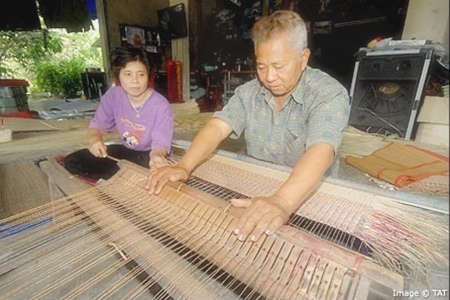
Many orchards are looking long-term and shifting to organic culture. The practice costs more to start up, but is better for the land and yields higher quality fruit.
Seafood is another specialty. Chanthaburi’s beachside restaurants offer the daily catch which they claim is the freshest and tastiest in the land.
Chanthaburi is also known for woven reed mats. Bang Sa Kao in Laem Singh district is a community that lives off the reed products. This really started in 1972 when Suriya Kaenchan persuaded her neighbours to form a group to solve the problem of falling prices for mats and exploitation by middlemen. They started with five families and have grown to 200. The community offers weaving demonstrations and recounts the history of their craft, which turns out everything from mats to purses and sandals.
NATURE OUTINGS
The quantity and quality of nature outings in the province is astounding in a province blessed with a fine coastline, bays, rivers, mountains and forests.
Mountains and Waterfalls
Phliu waterfall in Namtokphliu National Park, mentioned above, offers a beautiful, but steep, 1.2-kilometre walk through a tropical forest up and around the waterfall and back down on the other side. The trail is well marked and a fantastic introduction to the mountain forests of the region.
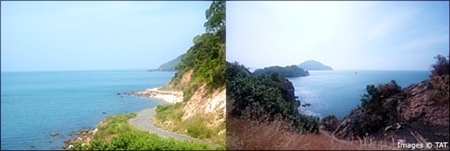
Khao Khitchakut National Park, a bit less than 30 kilometres north of town, is known for Krathing waterfall and has several trails to the waterfall that are famous hikes. There are some smaller waterfalls in the park as well.
Khao Soi Dao in the north of the province offers the most arduous hike. It takes half a day but rewards with a grand view at the top and forests along the way. It’s a tough hike but the many repeat visitors attest to its popularity.
The Coasts Mangroves
There is easy access here to some of the largest remaining mangroves in Thailand. Looking into a large stand of mangrove can feel like peering back into prehistoric times. You half expect to see a brontosaurus staring back at you. Entry into the tightly packed roots twisted up above the seawater is pretty much impossible, but there are board walks for a closer look and boat and kayaks trips available to skirt the edges. The shallow water is clear with a lot of organic matter floating above a muddy floor. There are no dinosaurs – well probably not – but there are birds and abundant aquatic life.
Stare into one for a while and you immediately realise that they form a vital part of the ecosystem. Mangroves, where so much aquatic life begins, are being destroyed worldwide at an alarming rate.
There are mangroves along the border with Trat province called the Welu wetlands where eagles feed.
Sustainable green tourism is gaining ground. Faasai Resort and Spa at Kung Wiman, for example, is situated in some of the most scenic landscape in eastern Thailand near mangrove-fringed Kung Kraben bay and next to an eight-kilometre-long forest reserve on the coast.
Many visit Kung Wiman for the day and finish at one of the beachside restaurants serving fresh fish. Faasai is now attracting eco-tourists from Bangkok and abroad.
Owned and operated by Bronwen Evans and Surin Laopha, Faasai works in collaboration with local authorities to help promote tourism in order to boost the local economy. Both agree that tourism growth needs to be sustainable and targeted at niche rather than mass-market travellers in order to enhance the natural advantages of Kung Wiman.
“Our unique location combines coastal breezes, mountain mists and a warm temperate climate so there is real biodiversity and amazing plants, insects and animals to marvel at,” says Evans.
There is a growing eco-traveller market globally and Faasai offers those adventurers a comfortable option in one of the most attractive corners of Thailand.
The province is also a growing destination for bicycle enthusiasts with bike lanes along many of the rural roads.
Cambodia’s opening up of its borders has made Chanthaburi an even more attractive place to visit while travelling the region. The ancient Khmer ruins at Angkor are only about 200 kilometres northeast across the border. The border itself offers interesting markets on the Thai side.
Visitors can also venture into Ranong province to the west and Trat province squeezed between Chanthaburi and Cambodia to the east with many islands just offshore.
ACKNOWLEDGEMENTS
News Room thanks Faasai Resort and Spa for their hospitality and kind support for this feature.
Contact information:
Faasai Resort and Spa
Tel: +66 (0) 3941 7404
E-mail: [email protected]
Web site: www.faasai.com


